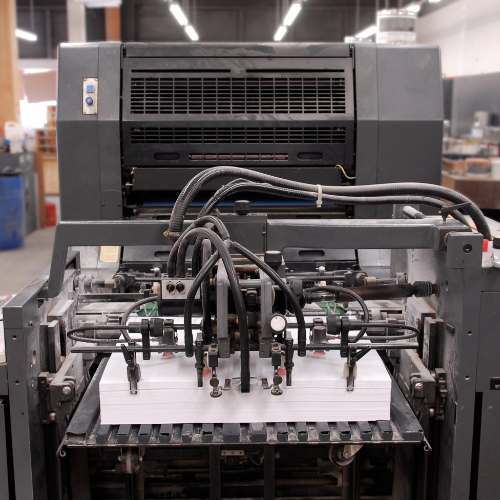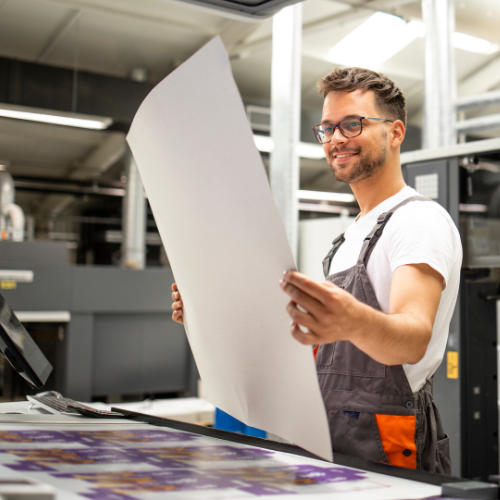What is Sheetfed Offset Printing?
In a world surrounded by printed materials, from the pages of your favorite magazine to the intricate consumer products packaging, one printing method stands out for its exceptional quality and precision—sheetfed offset printing. What makes sheetfed offset printing even more remarkable is its ability to adapt to a wide range of substrates.
For decades, Zeller+Gmelin has been at the forefront of ink production, specializing in sheetfed offset printing inks that consistently meet and exceed the demands of the industry. In this blog, we’ll discuss what is sheetfed offset printing and explore how it works, its broad range of applications, and the many advantages and occasional limitations associated with this printing method. We’ll also highlight the diverse substrates sheetfed offset printing can master. If you have any questions, seek advice, or want to explore Zeller+Gmelin’s sheetfed offset printing, please get in touch with our team. We’re here to serve you!
Understanding Sheetfed Offset Printing
Sheetfed offset printing is an intricate and highly precise printing technique based on the idea that oil and water do not mix. This method requires the printing plate areas carrying the design to be treated with ink while the non-print areas are kept damp with water, allowing only the ink to adhere to the plate.
It is called “sheetfed” because it involves feeding individual sheets of paper or other printing substrates into the printing press, as opposed to web offset printing, which uses continuous rolls of paper. This approach is known for its incredible color reproduction, sharp details, substrate versatility and consistent print quality. It is often used for print jobs where quality and flexibility are crucial though it is not as cost-effective as other print methods.
Equipment Involved in Sheetfed Offset Printing
To gain a deep understanding of sheetfed offset printing, let’s break down its key components:
Printing Plate: The printing plate is the linchpin of the entire process. Typically made from aluminum or polyester, the plate has areas that are either hydrophilic (attracting water) or hydrophobic (repelling water) to facilitate the offset printing process. The plate will carry the image to be transferred to the printing blanket and each color used in the design requires a separate printing plate.
Ink Rollers: Ink rollers are responsible for applying ink to the printing plates. The ink will adhere to the non-damp portions of the plate and fall back into the pan for the non-print areas. The ink is then transferred from the plates to a rubber blanket cylinder.
Blanket Cylinder: The rubber blanket cylinder receives the inked image from the plates and then transfers it onto the paper or substrate. This indirect transfer method is the hallmark of offset printing and is what gives it its name.
Paper or Substrate: Individual sheets of paper, paperboard or other substrates are fed into the press, each carrying the final printed image.
Drying Unit: After each color application, the sheets pass through a drying unit. This ensures that the ink dries quickly and does not smudge, resulting in a clean and finished print.
Finishing: Following the printing stage, post-printing processes such as cutting, folding, and binding may be required to prepare the printed sheets for its intended purpose.
Applications of Sheetfed Offset Printing
Sheetfed offset printing is incredibly versatile and finds its application in a wide array of projects, including:
Brochures and Catalogs: Offset printing is ideal for producing high quality brochures, magazines, newsletters and catalogs, ensuring sharp text and vibrant images that capture the essence of the content. Sheetfed offset is also ideal for handling large volumes of text and images with excellent color accuracy, making it a popular choice for publications.
Packaging: The method is a popular choice for packaging materials, such as product boxes, labels and cartons, delivering high-quality graphics for consumer goods, luxury items, and much more. It can provide consistent and precise color reproduction on various packaging substrates.
Business Stationery: Offset printing is commonly used for business cards, letterheads, envelopes, and other forms of stationery. It lends a professional touch to corporate branding and communication.
Posters and Art Prints: The method’s exceptional ability to capture intricate details makes it suitable for producing high-quality posters and art prints. It is the choice of artists and designers who seek to reproduce their work with the utmost fidelity.
Books & Education Materials: Workbooks, textbooks, handbooks and other educational materials require high-quality and intricate printing to ensure that text and images are clear and legible.
Sheetfed Offset Printing on Various Substrates
One of the remarkable features of sheetfed offset printing is its ability to work with a diverse range of substrates. Here are some of the substrates that sheetfed offset printing can effectively handle:
Paper: This is the most common substrate for sheetfed offset printing. It comes in various types, including coated and uncoated paper, cardstock, and specialty papers. Different paper types can be chosen based on the specific requirements of the print job.
Paperboard: Paperboard is a thicker and sturdier material than standard paper. It’s commonly used for packaging applications, such as folding cartons for food products, cosmetics, pharmaceuticals, and various consumer goods.
Metallic Foils: For a touch of luxury and a decorative shine, sheetfed offset printing can utilize metallic substrates like foil. These are often used in specialty packaging, labels, and promotional materials to create eye-catching effects.
Laminates: Laminated materials, such as laminated paperboard, are used for applications that require additional protection or a specific finish. They can be printed using sheetfed offset methods.
Synthetic Materials: Synthetic substrates, such as synthetic papers, are used for applications where durability and resistance to water or other environmental factors are important. They are commonly used for outdoor signage, labels, and tags.
Plastic Films: Sheetfed offset printing can also be used to print on plastic films. This includes materials like polyethylene, polypropylene, and polyester. Plastic films are often used for flexible packaging, such as plastic bags, shrink sleeves, and pouches.
Advantages and Limitations of Sheetfed Offset Printing
Advantages:
High Quality: Offset printing excels in delivering sharp, high-resolution images and crisp text details with precise color matching. This makes it the top choice for projects where quality is paramount.
Versatility: It accommodates various paper types, sizes, and substrates, making it adaptable to a wide range of printing needs. Whether you’re printing on glossy paper, heavy cardstock, or specialty substrates, offset printing delivers.
Cost-Effective for Medium to Large Runs: While the setup costs can be relatively high, the cost per unit decreases as the print quantity increases. This makes it a cost-effective choice for medium to large print runs, where the initial setup costs are amortized over a larger number of prints.
Limitations:
Setup Time: The setup process can be time-consuming, which can make it less ideal for short print runs. However, many presses now come equipped with quick-changeover systems, reducing setup times significantly.
Not Ideal for Extremely Short Runs: Due to setup and plate costs, offset printing may not be cost-effective for very small print jobs, where the initial setup costs can outweigh the benefits of the method’s high quality.
Higher Costs. The equipment and technology required for sheetfed offset printing are relatively expensive. This can make it challenging for smaller printing companies to enter the market and for smaller brands to work with sheetfed printers.
Environmental Considerations: The process may involve the use of volatile organic compounds (VOCs) in the inks, which can have environmental implications. However, the printing industry has made significant strides in developing more eco-friendly inks and practices.
Maintenance & Expertise. Sheetfed offset presses are rather technical and require skilled operators to keep production running profitably. These machines are also incredibly expensive and require regular maintenance to ensure the equipment is running optimally.
The Future of Sheetfed Offset Printing
Sheetfed offset printing has remained a go-to choice for those who demand precision, quality, and versatility. As technology and automation continues to advance, innovations in ink and press technology push the boundaries of what is possible. Zeller+Gmelin has consistently been at the forefront of these innovations, offering a wide range of sheetfed inks, including a NEW specialty cold foil adhesive, designed to meet the demands in sheetfed offset printing.
Whether you’re just embarking on your journey with sheetfed or you’re looking to enhance your current capabilities, consider Zeller+Gmelin for your printing ink needs. To learn more about our sheetfed offset printing inks, click here or reach out to our team to discuss your unique print goals. We’re here to support you!


